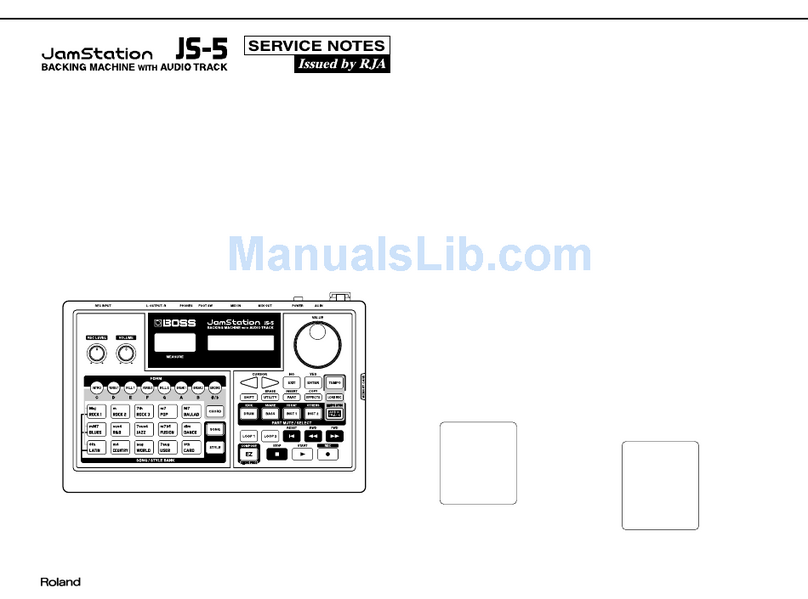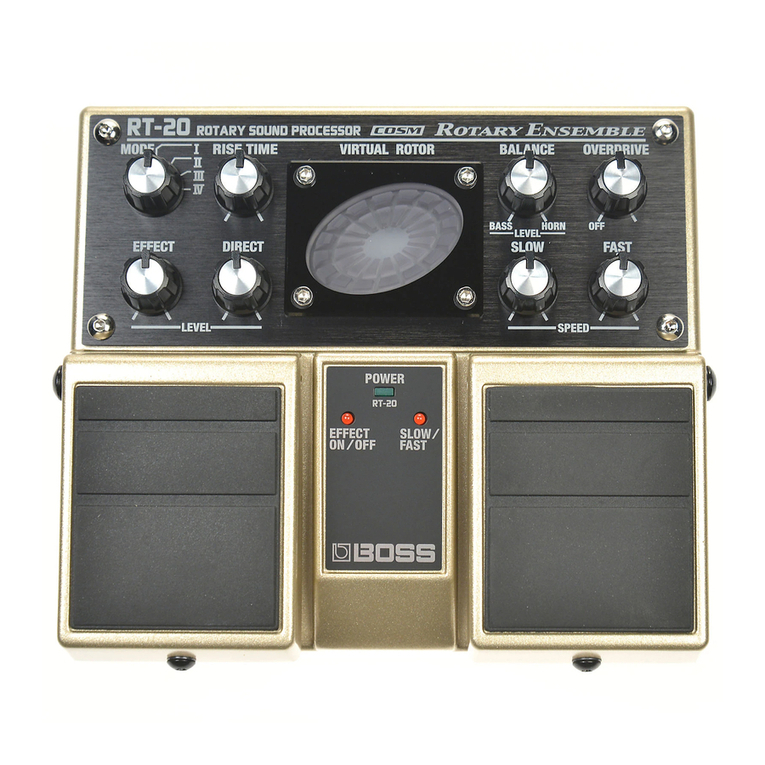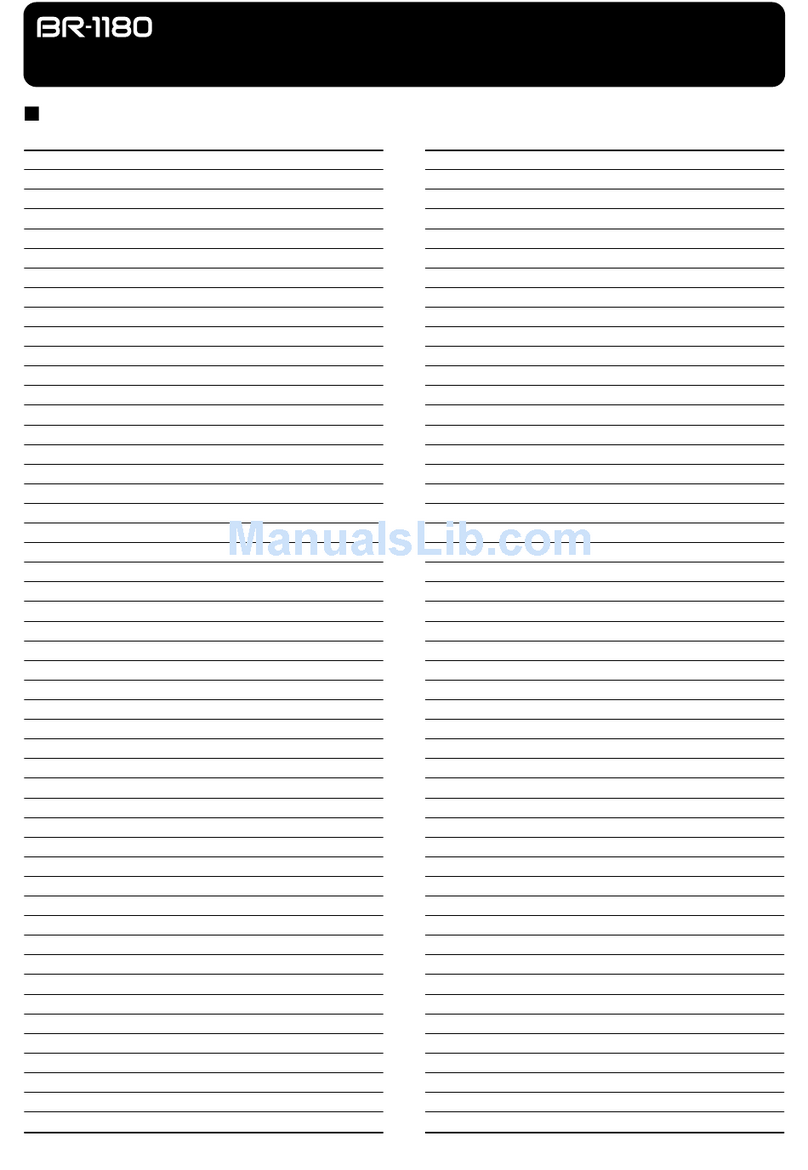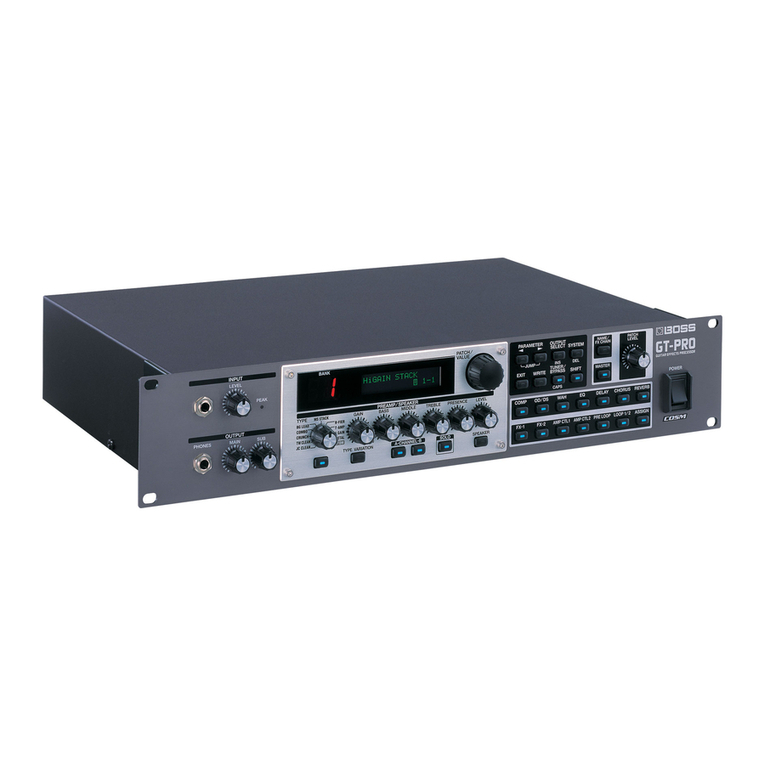BOSSCO DD-500 User manual

Getting Ready. . . . . . . . . . . . . . . . . . . . . . . . . . . 2
Installing the Batteries . . . . . . . . . . . . . . . . . . 2
Connecting the Equipment. . . . . . . . . . . . . . . 2
Turning the Power On . . . . . . . . . . . . . . . . . . 4
Basic Operation . . . . . . . . . . . . . . . . . . . . . . . . . 5
Adjusting the Delay . . . . . . . . . . . . . . . . . . . . 5
Turning Delay On/O . . . . . . . . . . . . . . . . . . . 6
Switching Banks/Patches . . . . . . . . . . . . . . . . 7
Using the [TAP/CTL] Switch to Control the Delay 8
Playing Phrase Loops . . . . . . . . . . . . . . . . . . . 9
Editing a Patch . . . . . . . . . . . . . . . . . . . . . . . . . . 10
Saving a Patch . . . . . . . . . . . . . . . . . . . . . . . . . . 11
Parameter List . . . . . . . . . . . . . . . . . . . . . . . . . . 12
PATCH . . . . . . . . . . . . . . . . . . . . . . . . . . . . . . 12
CONTROL . . . . . . . . . . . . . . . . . . . . . . . . . . . 14
ASSIGN . . . . . . . . . . . . . . . . . . . . . . . . . . . . . 15
SYSTEM. . . . . . . . . . . . . . . . . . . . . . . . . . . . . 17
MIDI . . . . . . . . . . . . . . . . . . . . . . . . . . . . . . . 17
MIDI PC MAP . . . . . . . . . . . . . . . . . . . . . . . . . 18
Convenient Functions . . . . . . . . . . . . . . . . . . . . 19
Specifying Whether to Carry-Over the Delay
Sound. . . . . . . . . . . . . . . . . . . . . . . . . . . . . . 19
Assigning the Functions of the [A], [B], and
[TAP/CTL] Switches . . . . . . . . . . . . . . . . . . . . 19
Synchronizing with a DAW or External MIDI
Device. . . . . . . . . . . . . . . . . . . . . . . . . . . . . . . . . 20
Connection Example . . . . . . . . . . . . . . . . . . . 20
MIDI Messages That Can Be Transmitted and
Received . . . . . . . . . . . . . . . . . . . . . . . . . . . . 20
MIDI Messages That Can Only Be Received. . . . 21
MIDI Routing . . . . . . . . . . . . . . . . . . . . . . . . . 21
Assigning a Function to an External Pedal. . . . . 22
Restoring the Factory Default Settings . . . . . . . 24
Transmitting Data to an External MIDI Device. . 24
Troubleshooting. . . . . . . . . . . . . . . . . . . . . . . . . 25
Main Specications . . . . . . . . . . . . . . . . . . . . . . 25
USING THE UNIT SAFELY. . . . . . . . . . . . . . . . . . . 26
IMPORTANT NOTES . . . . . . . . . . . . . . . . . . . . . . 26
Before using this unit, carefully read“USINGTHE UNIT SAFELY”and“IMPORTANT NOTES”
(leaet“USINGTHE UNIT SAFELY”and Owner’s Manual (p. 26)). After reading, keep the
document(s) including those sections where it will be available for immediate reference.
5High-precision 96 kHz 32-bit audio processing from input to output ensures high audio quality.
5Easily visible delay time indication and an independent [TAP/CTL] switch provide sophisticated
functionality that’s easy to use in live performance.
5A total of 12 dierent delay modes, including“VINTAGE DIGITAL” that models the SDE-3000 and
DD-2, as well as “ANALOG”and “TAPE.”
5The memory function lets you store and recall 297 dierent setups from internal memory.
“CARRY OVER”provides seamless transition that preserves the reverberant sound when
switching between patches.
5“Phrase Loop” function lets you layer new material in real time while recording and playing back.
This can be used simultaneously with delay.
5By connecting the DD-500 via a USB cable or MIDI cables, you can switch sounds and control
parameters in synchronization with your computer DAW or an external MIDI device.
© 2015 Roland Corporation
Owner’s Manual

2
Getting Ready
Installing the Batteries
Install four alkaline batteries (AA, LR6) in the battery compartment located on the bottom of the
unit.
* When turning the unit over, be careful so as to protect the buttons and knobs from damage.
Also, handle the unit carefully; do not drop it.
* If you handle batteries improperly, you risk explosion and uid leakage. Make sure that you
carefully observe all of the items related to batteries that are listed in“USING THE UNIT SAFELY”
and “IMPORTANT NOTES”(separate sheet “USING THE UNIT SAFELY” and Owner’s manual (p. 26)).
* We recommend that you keep batteries installed in the unit even though you’ll be powering it
with the AC adaptor. That way, you’ll be able to continue a performance even if the cord of the
AC adaptor gets accidently disconnected from the unit.
* To prevent malfunctions or accidents, install or replace the batteries before connecting the unit
to other equipment.
* “BATTERY LOW” will appear on the display if the batteries are low. Replace them with new ones.
Attaching the Rubber Feet
You can attach the rubber feet (included) if necessary.
Attach them in the locations shown in the illustration.
Connecting the Equipment
* To prevent malfunction and equipment failure, always turn down the volume, and turn o all
the units before making any connections.
* Be sure to minimize the volume of your amp before you connect or disconnect cables.
DC IN jack
Accepts connection of an AC Adaptor (PSA series; sold
separately). By using an AC Adaptor, you can play without
being concerned about how much battery power you have left.
* Use only the specied AC adaptor (PSA series; sold
separately), and connect it to an AC outlet of the correct
voltage. Do not use any other AC adaptor, since this may
cause malfunction.
* If the AC adaptor is connected while power is on, the power
supply is drawn from the AC adaptor.
USB (O) port
Use a commercially available
USB 2.0 cable to connect this
port to your computer.
You can synchronize with a
DAW via MIDI.
MIDI IN, OUT connectors
Connect an external MIDI
device here.
You can synchronize with
an external MIDI device
via MIDI.
MIDI device

3
Getting Ready
CTL 1 ,2/EXP jack
You can control various parameters by connecting a footswitch (FS-5U, FS-5L, FS-6, FS-7: sold separately) or an expression pedal (such as
the Roland EV-5: sold separately) to the CTL 1, 2/EXP jack (p. 22).
INPUT A/MONO, B jacks
Connect your electric guitar, or another
instrument or eect unit, to these jacks.
* Use the INPUT A/MONO jack and B jack
when connecting a stereo-output eects
unit. Use only the INPUT A/MONO jack if
you’re using a mono source.
* The INPUT A/MONO jack doubles as
the power switch. Power to the unit is
turned on when you plug into the INPUT
A/MONO jack; the power is
turned o when the cable is
unplugged.
OUTPUT A/MONO, B jacks
Connect these jacks to your amp or monitor speakers.
If you’re using a mono setup, use only the OUTPUT A/MONO jack.
* Do not connect headphones to the OUTPUT A/MONO, B jacks.
Doing so may damage the headphones.
When connecting EV-5
EXP
* Use only the specied
expression pedal (EV-5; sold
separately). By connecting any
other expression pedals, you
risk causing malfunction and/
or damage to the unit.
When Connecting an FS-7
Stereo 1/4”phone type
,1/4” phone type x 2
When Connecting an FS-6
MODE/POLARITY switch
CTL 2 CTL 1
Stereo 1/4”phone type
,Stereo 1/4”phone type
MODE/POLARITY switch
When Connecting an FS-5U
(or FS-5L)
When Connecting Two FS-5Us
(or FS-5Ls)
1/4” phone type ,1/4”
phone type
CTL 1 CTL 2 CTL 1
POLARITY switch
Stereo 1/4”phone type
,1/4” phone type x 2
When connecting an FS-5L, set MODE to
“MOMENT” (p. 22).

4
Getting Ready
Turning the Power On
* Once everything is properly connected (p. 2), be sure to follow the procedure below to turn
on their power. If you turn on equipment in the wrong order, you risk causing malfunction or
equipment failure.
1. Insert a plug into the INPUT A/MONO jack.
The DD-500 power turns on.
2. Turn on the power of your guitar amp or other equipment.
* This unit is equipped with a protection circuit. A brief interval (a few seconds) after turning the
unit on is required before it will operate normally.
* Before turning the unit on/o, always be sure to turn the volume down. Even with the volume
turned down, you might hear some sound when switching the unit on/o. However, this is
normal and does not indicate a malfunction.
* When turning the power o, do so in the reverse order.

5
Basic Operation
Adjusting the Delay
[MODE] knob
Selects the type of delay.
STANDARD Clear digital delay.
TERA ECHO Spacious echo sound with movement, neither reverb nor delay.
SLOW ATTACK Delay with a suppressed attack as if the volume is being faded-in.
FILTER Delay with a swept lter added.
SHIMMER Delay with pitch-shifted sound mixed in.
SFX Delay with a sound-eect character.
REVERSE Produces an eect where the sound is played back in reverse.
PATTERN Sixteen independently-settable delays.
DUAL A delay comprising two dierent delays connected either in series or in parallel.
VINTAGE DIGITAL Vintage digital delay with the warmth of an early unit.
TAPE Provides the characteristic wavering sound of the tape echo.
ANALOG Gives a mild analog delay sound.
[TONE] knob
Adjusts the tone of the eect’s sound.
The frequency response is at when
the knob is set to the center position;
turning it to the right boosts the higher
frequencies, and turning it to the left
cuts the higher frequencies.
[TIME/VALUE] knob
Adjusts the delay time.
To make larger changes in the value,
turn the knob while pressing it.
[E. LEVEL] knob
Adjusts the volume of the eect sound.
[TAP/CTL] switch
You can easily set the delay
time to match the tempo
of the song being played
by pressing the pedal
in time with the song’s
tempo (Tap Input).
If you like, you can assign
this switch to a dierent
function (p. 8).
[I] [H] buttons
Switch screens.
[H][I]
[H]
[I]
[H][I]
Tempo
Delay time
Note length relative to the tempo
[H]
[I]
Delay timeDelay time
Top screen
Turn the [TIME/VALUE] knob to adjust
the value.
[MOD DEPTH] knob
Adjusts the modulation depth of the
delay sound.
[FEEDBACK] knob
Adjusts the feedback level (or how
much the sound is repeated).
* Oscillation may occur with certain
input sounds, or when the knob is
set at certain positions.
[A] [B] switches
Switch banks/patches (p. 7).

6
Basic Operation
Turning Delay On/O
Patch A delay
Each time you press the [A] switch, the delay alternately turns on (lit blue) / o (unlit).
Patch B delay
Each time you press the [B] switch, the delay alternately turns on (lit blue) / o (unlit).
Press once
Blue: on Unlit: o
MEMO
You can also make settings so that patches A and B are used simultaneously (p. 19).
Patches and Banks
Settings for MODE, FEEDBACK, EFFECT LEVEL, TONE, MOD DEPTH, and TIME are collectively
called a “patch.”You can select patches using [A], [B], and [TAP/CTL] switches (p. 19). A
combination of patches A, B, and C is called a “bank.”
Bank down
Bank up
BANK 02
BANK 99
BANK 01
Patch 01A Patch 01B Patch 01C
* If you want to use the [TAP/CTL] switch to select patch C, refer to “Assigning the Functions of the [A], [B], and [TAP/CTL]
Switches” (p. 19).

7
Basic Operation
Switching Banks/Patches
1. Switch banks (01–99).
Bank down (press the [A] and [B] switches simultaneously)
Bank up (press the [B] and [TAP/CTL] switches simultaneously)
2. Press a blinking switch ([A] or [B]) to switch patches.
Blinking blue
MEMO
You can recall a dierent patch by turning the [TIME/VALUE]
knob while you hold down the [EXIT] button.
MEMO
You can use the following functions to switch patches/banks.
5“Assigning the Functions of the [A], [B], and [TAP/CTL] Switches”(p. 19)
5“Specifying Whether to Carry-Over the Delay Sound” (p. 19)

8
Basic Operation
Using the [TAP/CTL] Switch to Control the Delay
With the default settings, the [TAP/CTL] switch is used for tap input, but you can change this
setting to make the switch aect the delay in various ways.
1. Press the [EDIT] button.
2. Use the [H] [I] buttons to select “CONTROL” and then press the
[EDIT] button.
3. Use the [H] [I] buttons to select “TAP/CTL,” and use the [TIME/
VALUE] knob to assign a function.
Value Explanation
TAP Use the switch for tap input.
CTL
HOLD Repeats the delay sound while you hold down the switch.
WARP Simultaneously controls the delay sound’s feedback level and volume to produce a totally unreal delay.
TWIST A new type of delay that produces an aggressive, spinning sensation.
MOMENT Outputs the delay sound only while you hold down the switch.
ROLL 1/2 Cuts the delay time to 1/2 the setting only while you hold down the switch.
ROLL 1/4 Cuts the delay time to 1/4 the setting only while you hold down the switch.
ROLL 1/8 Cuts the delay time to 1/8 the setting only while you hold down the switch.
FADE IN Fades-in the delay sound.
FADE OUT Fades-out the delay out.
ASSIGN Select this if you’re using the ASSIGN 1–8 setting (p. 15).
4. Press the [EXIT] button to return to the top screen.

9
Basic Operation
Playing Phrase Loops
By operating the switches, you can carry out recording and playback in real time to create layered
performances. You can apply the delay while creating layered performances.
Exit
To exit Phrase Loop, hold down the [TAP/CTL] switch for at least two seconds while
stopped.
* The recorded content will be erased when you exit Phrase Loop.
* The recorded content will not be saved.
Overdub
Record additional layers
while playing back the
loop.
[A] and [B] are lit red.
Loop playback
[B] is lit red.
Record
Record the
performance.
[A] is lit red.
Enter Phrase Loop mode
If you hold down the blue-lit [A] or [B] switch for two seconds or longer, the Phrase
Loop enters the standby condition, and [A] blinks red.
Red
Stop
Stop playback.
[B] blinks in red.
Clear
Erase the phrase.
[A] blinks in red.
Recording time (seconds)
Frequency 48 kHz 96 kHz
Mono 120 60
Stereo 60

10
Editing a Patch
You can edit a variety of patch-related parameters.
1. Press the [EDIT] button.
2. Use the [H] [I] buttons to select “PATCH,” and then press the
[EDIT] button.
3. Use the [H] [I] buttons to select a parameter, and use the [TIME/
VALUE] knob to edit the value.
4. Press the [EXIT] button to return to the top screen.
* Save the edited patch as described in the procedure on “Saving a Patch” (p. 11).
Basic [EDIT] operations
Use the [H][I] buttons to move the cursor
Use the [TIME/VALUE] knob to edit the value
[EDIT] button
Use the [H][I] buttons
to move the cursor
[EDIT] button
[EXIT] button

11
Saving a Patch
Here’s how to save a patch that you’ve edited.
1. Press the [EXIT] button and [EDIT] button simultaneously.
2. Use the [TIME/VALUE] knob to select the save-destination
number.
Bank [A] switch [B] switch [TAP/CTL] switch
Bank 01 01A 01B 01C
Bank 02 02A 02B 02C
::::
Bank 99 99A 99B 99C
* If you want to use the [TAP/CTL] switch to select patch C, refer to“Assigning the Functions of
the [A], [B], and [TAP/CTL] Switches”(p. 19).
3. Press the [H] button to select the patch name.
4. Edit the patch name.
[H] [I] buttons Move the cursor
[TIME/VALUE] knob Edit the character
5. Press the [EDIT] button to save the patch.
If you decide to cancel, press the [EXIT] button.
By moving the cursor to “WRITE TO” and turning the [TIME/VALUE] knob, you can initialize a
patch or exchange patches.

12
Parameter List
PATCH
Parameter Explanation
MODE Selects the type of delay (p. 5). The same function as the [MODE] knob.
TIME Species the delay time. The same function as the [TIME/VALUE] knob.
BPM Species the tempo.
NOTE Species the delay time with the note length relative to BPM.
FEEDBACK Adjusts the feedback level (or how much the sound is repeated). Higher settings will result in more delay
repeats. The same function as the [FEEDBACK] knob.
TONE Adjusts the tone of the delay sound. The same function as the [TONE] knob.
EFFECT LEVEL Adjusts the volume of the delay sound. The same function as the [E. LEVEL] knob.
MOD DEPTH Adjusts the modulation depth of the delay sound. The same function as the [MOD DEPTH] knob.
MOD RATE Adjusts the modulation rate of the delay sound.
CARRY OVER You can specify whether the eect sound is carried-over when you switch patches or turn the delay o.
DIRECT LEVEL Adjusts the volume of the direct sound when the eect is on.
EQ SW Turns the EQ on/o.
EQ LO.CUT Sets the frequency at which the low cut lter begins to take eect.
When “FLAT” is selected, the low cut lter will have no eect.
EQ LO.GAIN Adjusts the low frequency range tone.
EQ LM.GAIN Adjusts the low-middle frequency range tone.
EQ LM.FREQ Species the center of the frequency range that will be adjusted by the LM.GAIN.
EQ LM.Q Adjusts the width of the area aected by the EQ centered at the LM.FREQ. Higher values will narrow the area.
EQ HM.GAIN Adjusts the high-middle frequency range tone.
EQ HM.FREQ Species the center of the frequency range that will be adjusted by the HM.GAIN.
EQ HM.Q Adjusts the width of the area aected by the EQ centered at the HM.FREQ. Higher values will narrow the area.
EQ HI.GAIN Adjusts the high frequency range tone.
EQ HI.CUT Sets the frequency at which the high cut lter begins to take eect.
When “FLAT” is selected, the high cut lter will have no eect.
EQ LEVEL Adjusts the overall volume level of the equalizer.
LO DAMP Adjusts the amount by which the low frequency range is reduced each time the eect sound is repeated.
LO DAMP F Species the frequency of the low range that is reduced by LO DAMP.
HI DAMP Adjusts the amount by which the high frequency range is reduced each time the eect sound is repeated.
HI DAMP F Species the frequency of the high range that is reduced by HI DAMP.
DUCK SENS Adjusts the sensitivity at which the volume is automatically adjusted according to the input. Higher values
allow the adjustment to occur in response to lower volumes.
DUCK PRE DEPTH The volume being“input” to the delay is automatically reduced when the input sound is loud. The amount of
reduction increases as this setting approaches 100.
DUCK POST DEPTH The volume being“output” to the delay is automatically reduced when the input sound is loud. The amount
of reduction increases as this setting approaches 100.
EFFECT PAN Adjusts the stereo position of the eect sound.
DIRECT PAN Adjusts the stereo position of the direct sound.

13
Parameter List
MODE: TERA ECHO
Parameter Explanation
RESONANCE This adjusts the amount of resonance (and the tone coloration) of the eect sound.
MODE: SLOW ATTACK
Parameter Explanation
SENS
Adjusts the sensitivity of the slow gear.
When it is set to a lower value, the eect of the slow gear can be obtained only with a stronger picking, while
no eect is obtained with a weaker picking. When the value is set higher, the eect is obtained even with a
weak picking.
RISE TIME Adjusts the time needed for the volume to reach its maximum from the moment you begin picking.
MODE: FILTER
Parameter Explanation
LFO TYPE Selects the curve at which the lter is moved.
LFO RATE Adjusts the rate at which the lter is moved.
LFO DEPTH Adjusts the range over which the lter is moved.
TYPE Selects the type of lter (LPF/BPF/HPF).
CUTOFF Adjusts the frequency at which the lter operates. Higher values raise the frequency.
RESONANCE Adjusts the operation of the lter. Higher values produce a stronger tonal character.
FILTER POS Species whether the lter is placed before or after the delay.
MODE: SHIMMER
Parameter Explanation
PITCH SHIFT Species the amount of pitch shift in semitone units.
PITCH FINE Species a ne adjustment to the amount of pitch shift. A change of 100 in the Fine setting corresponds
to a change of 1 in the Pitch Shift setting.
PITCH BAL Adjusts the balance between the pitch-shifted sound that is input to the delay and the direct sound.
DIRECT FB Adjusts the amount of feedback for the delay that is applied to the direct sound. This is specied as a
proportion (%) relative to the feedback specied by the [FEEDBACK] knob.
MODE: SFX
Parameter Explanation
BIT DEPTH Species the bit depth.
SAMPLE RATE Species the sampling rate.
LoFi BAL Adjusts the volume balance between the direct sound and the eect sound.
TR WAVE Adjusts changes in volume level. A higher value will steepen wave’s shape.
TR RATE Adjusts the frequency (speed) of the change.
TR DEPTH Adjusts the depth of the eect.
MODE: PATTERN
Parameter Explanation
PATTERN Selects the delay pattern.
You can choose from preset patterns PAT1–PAT10 and the USER pattern which you are free to set.
DELAY 1–16 TIME Adjusts the proportion relative to the Delay 1–16 delay time when PATTERN is set to “USER.”
DELAY 1–16 LEVEL Adjusts the Delay 1–16 volume when PATTERN is set to “USER.”
DELAY 1–16 PAN Adjusts the Delay 1–16 stereo position when PATTERN is set to “USER.”

14
Parameter List
MODE: DUAL
Parameter Explanation
DUAL MODE Species whether the two delays are connected in series or in parallel.
DUAL TYPE Selects the type of delay.
DUAL LINK Link the delay time and feedback of the second delay to the settings of the rst delay.
D2 TIME Species the delay time of the second delay. This is the same as the [TIME/VALUE] knob.
D2 FEEDBACK Adjusts the amount of feedback (repetition) for the second delay. Higher values produce a larger
number of delay repeats. This is the same as the [FEEDBACK] knob.
D2 E. LEVEL Adjusts the volume of the second delay sound. This is the same as the [E. LEVEL] knob.
MODE: VINTAGE DIGITAL
Parameter Explanation
TYPE Selects the type of unit that is being modeled.
FILTER Turns the high-cut lter on/o when TYPE is set to“SDE-3000.”
TIMEx2 Species whether the sampling frequency is halved and the delay time doubled when TYPE is set to
“SDE-2000” or “SDE-3000.”
MODE: TAPE
Parameter Explanation
TYPE Selects the type of unit that is being modeled.
MODE: ANALOG
Parameter Explanation
STAGE Species the number of BBD stages. The delay time lengthens in proportion to the number of stages.
CONTROL
Parameter Explanation
TAP/CTL Species whether the [TAP/CTL] switch is used as TAP or as CTL.
CTL FUNC Species how the [TAP/CTL] switch operates when pressed if it is being used as CTL.
CTL 1/2 PREF Species whether the CTL 1/2 switch has a dierent setting for each patch or the same setting shared by all
patches.
CTL 1/2 FUNC Species the operation that occurs when the CTL 1/2 switch is pressed.
CTL 1/2 MODE Species whether the setting is on only while the CTL 1/2 switch is held down or whether the setting
alternates on/o each time the switch is pressed.
EXP PREF Species whether the EXP pedal has a dierent setting for each patch or the same setting shared by all
patches.
EXP FUNC Species the operation that occurs when the EXP pedal is pressed.

15
Parameter List
ASSIGN
ASSIGN COMMON
Parameter Explanation
SENS (INPUT SENS) This adjusts the input sensitivity when INPUT LEVEL is selected for SOURCE.
ASSIGN 1–8
Parameter Value Explanation
SW OFF, ON Turns the ASSIGN 1–8 on/o.
SOURCE
Species the controller (source).
TAP/CTL [TAP/CTL] switch.
EXP PDL
(EXP PEDAL)
External footswitch (EV-5 etc.; available separately) connected to the CTL 1,2/
EXP jack.
CTL1, 2 PDL External footswitch connected to the CTL 1,2/EXP jack.
INT PDL
Internal pedal
The virtual expression pedal will begin operating when started
by the specied trigger (TRIGGER), modifying the parameter
specied by “TARGET.”
For details on the parameters that can be assigned to the
internal pedal, refer to “TIME” and “CURVE” (p. 16)
WAVE PDL
Wave pedal
The virtual expression pedal will cyclically modify the parameter specied by
“TARGET” in a xed wave form.
INPUT
(INPUT LEVEL)
The assigned target parameter will change according to the input level.
* If you want to adjust the input sensitivity, set the SENS (INPUT SENS).
CC#1–31, CC#64–95 Controller number from an external MIDI device
MODE
(SOURCE MODE)
Species the operation of the controller.
MOMENT
The value will normally be OFF (minimum value), and will be ON
(maximum value) only while the control is being operated.
* If you want to use the internal pedal or wave pedal, set to “MOMENT.”
TOGGLE The value will toggle between OFF (minimum) and ON (maximum) each time
the control is operated.
TRG This selects the parameter to be changed.
MIN (TARGET MIN)
MAX (TARGET MAX)
Species the range of change for the parameter. The values will depend on the parameter that’s
assigned by “TARGET.”
ACT.LO
(ACT RANGE LO)
Within the operating range of the source, this species the range that will control the target
parameter.
The target parameter will be controlled within the range specied. Normally, you should leave ACT.LO
at “0” and ACT.HI at“127.”
ACT.HI
(ACT RANGE HI)
WAV.RT
(WAVE RATE)
*1
0–100,
BPM –Species the time for one cycle of the wave pedal.
* If, due to the tempo, the time is longer than the range of allowable settings, it is then synchronized
to a period either 1/2 or 1/4 of that time.

16
Parameter List
Parameter Value Explanation
WAV.FM
(WAVE FORM)
*1
SAW, TRI, SIN
Select one of the following to specify the change produced by the wave pedal.
SAW TRI SIN
TRIGGER
(INT PEDAL TRIGGER)
*2
Species how the motion of the internal pedal will be triggered.
PAT CNG
(PATCH CHANGE) This is activated when a patch is selected.
EXP LO This is activated when an external expression pedal connected to the CTL 1,2/
EXP jack is set to the minimum position.
EXP MID This is activated when the external expression pedal connected to the CTL 1,2/
EXP jack is moved through the middle position.
EXP HI This is activated when the external expression pedal connected to the CTL 1,2/
EXP jack is set to the maximum position.
CTL1, 2 PDL This is activated when an external footswitch connected to the CTL 1,2/EXP
jack is operated.
CC#1–#31
CC#64–#95 This is activated when a control change is received.
TIME
(INT PEDAL TIME)
*2
0–100 This species the time over which the internal pedal will move from the toe-
raised position to the toe-down position.
CURVE
(INT PEDAL CURVE)
*2
LINEAR,
SLOW (SLOW RISE),
FAST (FAST RISE)
Select one of the following curves to specify the change produced by the
internal pedal.
LINEAR SLOW FAST
*1 SOURCE=INT PDL only
*2 SOURCE=WAVE PDL only

17
Parameter List
SYSTEM
Parameter Explanation
CONTRAST Adjusting the contrast of the display
OUTPUT Selects how output occurs.
BANK MODE Species the timing at which the patch is changed when you change banks.
BANK EXTENT MIN Sets the lower limit for the banks.
BANK EXTENT MAX Sets the upper limit for the banks.
KNOB LOCK Species whether knob operations will be disabled.
KNOB MODE Species how knob operations occur.
BYPASS Species how the bypass sound is output.
PEDAL ACT Species whether the operation occurs when you press the [A], [B], or [TAP/CTL] switch or when you release
the switch.
FSW HOLD TIME Species the number of seconds of holding down the [A], [B], or [TAP/CTL] switch that is interpreted as a
long-press.
FSW MODE Species how the footswitch is used (p. 19).
USB MODE Species the USB operating mode (p. 21).
LOOP MODE Species the sampling frequency.
MIDI
Parameter Explanation
Rx CHANNEL Species the receive channel.
Tx CHANNEL Species the transmit channel.
PC IN Species whether program changes are received.
PC OUT Species whether program changes are transmitted.
CC IN Species whether control changes are received.
CC OUT Species whether control changes are transmitted.
TIME CONTROL Species whether operations of the [TIME/VALUE] knob are transmitted and received.
A SW CC [A] switch
Species the controller number of the corresponding knobs or switches.
B SW CC [B] switch
TAP/CTL SW CC [TAP/CTL] switch
FEEDBACK CC [FEEDBACK] knob
E. LEVEL CC [E. LEVEL] knob
TONE CC [TONE] knob
MOD DEPTH CC [MOD DEPTH] knob
CTL1 CC External CTL1 switch
CTL2 CC External CTL2 switch
EXP CC External EXP pedal
EFFECT ON/OFF CC Species the controller number that switches between delay-on and bypass.
LOOP ON/OFF CC Species the controller number that switches the phrase loop function on/o.
LOOP REC/DUB CC Species the controller number that executes recording or overdubbing when using the phrase loop
function.
LOOP PLAY CC Species the controller number that executes loop playback when using the phrase loop function.
LOOP STOP CC Species the controller number that stops playback when using the phrase loop function.
LOOP CLEAR CC Species the controller number that clears the phrase when using the phrase loop function.
SYNC Selects the tempo clock input that is used for synchronization.
REALTIME SRC Selects the source of the realtime messages that are transmitted from the MIDI OUT connector or the USB
port.
MIDI IN->OUT Species the connector to which MIDI messages received from the MIDI IN connector are output.
USB IN->OUT Species the connector to which MIDI messages received from the USB port are output.
DEVICE ID Sets the MIDI Device ID used for transmitting and receiving System Exclusive messages.

18
Parameter List
MIDI PC MAP
Parameter Explanation
BNK-PC# Species the program number that corresponds to each patch number.

19
Convenient Functions
Specifying Whether to Carry-Over the Delay Sound
You can specify whether the eect sound is carried-over (ON/OFF) when you switch patches or
turn the delay o.
1. Press the [EDIT] button.
2. Use the [H] [I] buttons to select “PATCH,” and then press the
[EDIT] button.
3. Use the [H] [I] buttons to select “CARRY OVER,”and use the [TIME/
VALUE] knob to select ON / OFF.
4. Press the [EXIT] button to return to the top screen.
Assigning the Functions of the [A], [B], and [TAP/CTL] Switches
1. Press the [EDIT] button.
2. Use the [H] [I] buttons to select “SYSTEM”and then press the
[EDIT] button.
3. Use the [H] [I] buttons to select “FSW MODE,” and use the [TIME/
VALUE] knob to select the mode.
Mode Explanation
NORMAL
Use the [A] and [B] switches to select patch A or patch B, and use the [TAP/CTL]
switch for tap input.
* If you want to use the [TAP/CTL] switch as the CTL, set the “TAP/CTL FUNC”
to “CTL” (p. 8).
A/B/C Use the [TAP/CTL] switch to select patch C.
* In this case, you can't use the [TAP/CTL] switch for the TAP or CTL functions.
A/B SIMUL Patches A and B can be used simultaneously. Press the unlit [A] or [B] switch to
make both light.
SW DN/UP Use the [A] switch to turn delay on/o, and use the [B] switch and [TAP/CTL]
switch to change patches.
4. Press the [EXIT] button to return to the top screen.

20
Synchronizing with a DAW or External MIDI Device
You can synchronize your DD-500 performance with a computer or an external MIDI device by
sending and receiving MIDI messages.
For example, an external MIDI device or DAW could switch patches on the DD-500 or control its
tempo.
Connection Example
External MIDI device
DAW
MIDI Messages That Can Be Transmitted and Received
Patch changes
Bank select (CC#0, #32) and program change
Synchronization
Tempo clock (F8)
Patch data
System exclusive messages
Other messages
Switch, knob MIDI message Value Remarks
[A] switch Controller Number 82
ON, OFF 5Transmits “on” when pressed, “o” when released
5Transmits program change when the patch is changed
[B] switch Controller Number 83
[TAP/CTL] switch Controller Number 84
EXP pedal Controller Number 16 0–127
CTL 1 switch Controller Number 80 ON, OFF Transmits “on” when pressed,“o” when released
CTL 2 Switch Controller Number 81
[FEEDBACK] knob Controller Number 17
0–100
[TONE] knob Controller Number 19
[E. LEVEL] knob Controller Number 18
[MOD DEPTH] knob Controller Number 20
[TIME/VALUE] knob Pitch Bend -8192–
+8191
5Relative setting from the setting’s current value
5When MIDI TIME Control is on: transmitted and received
Must be ON
Other manuals for DD-500
1
Table of contents
Other BOSSCO Recording Equipment manuals

BOSSCO
BOSSCO BR Series Parts list manual

BOSSCO
BOSSCO SX-700 User manual

BOSSCO
BOSSCO BR-864 User manual

BOSSCO
BOSSCO SDE-3000EVH User manual
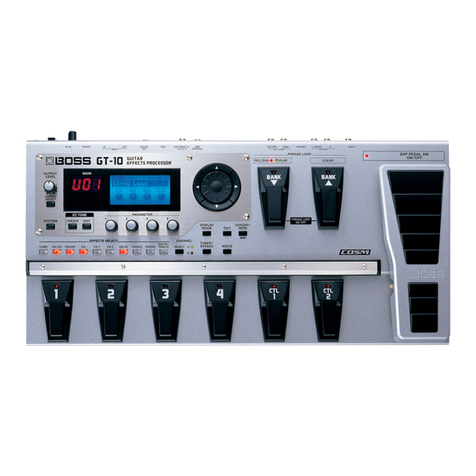
BOSSCO
BOSSCO GT-10 User manual
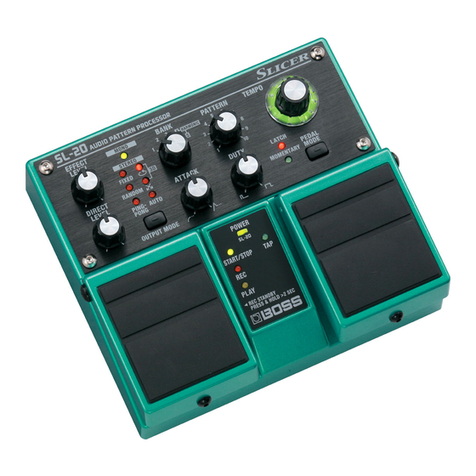
BOSSCO
BOSSCO Slicer SL-20 User manual
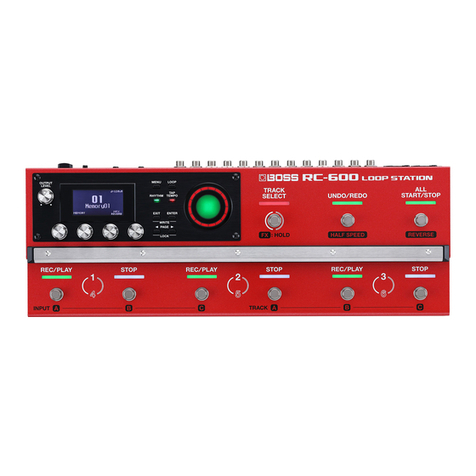
BOSSCO
BOSSCO RC-600 User manual

BOSSCO
BOSSCO BR-1600CD User manual

BOSSCO
BOSSCO BR-600 User manual

BOSSCO
BOSSCO BR-1600CD User manual

BOSSCO
BOSSCO ME-20 User manual
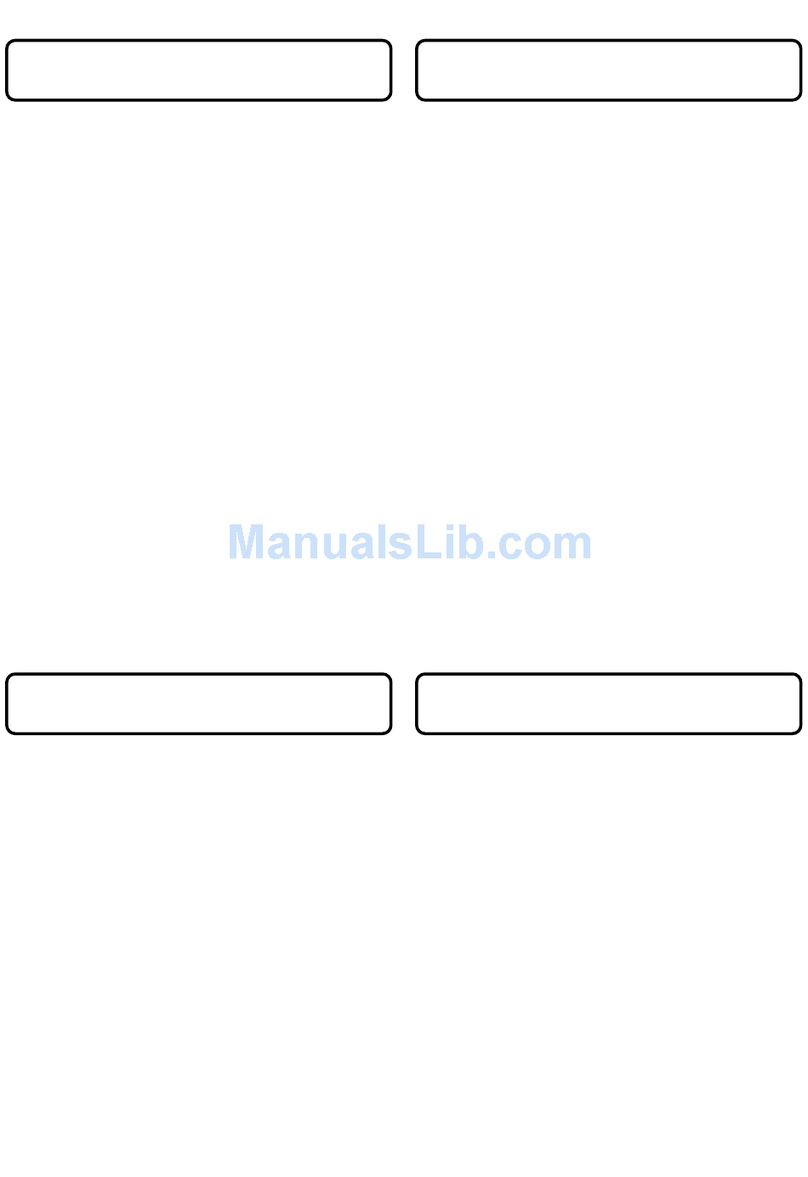
BOSSCO
BOSSCO BR-1600CD Manual
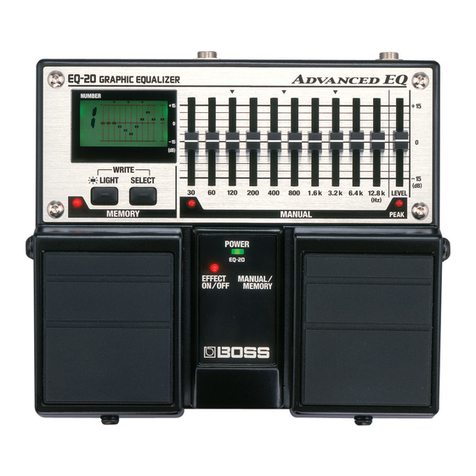
BOSSCO
BOSSCO EQ-20 Advanced EQ User manual

BOSSCO
BOSSCO VE-5 User manual

BOSSCO
BOSSCO BR-1180 User manual
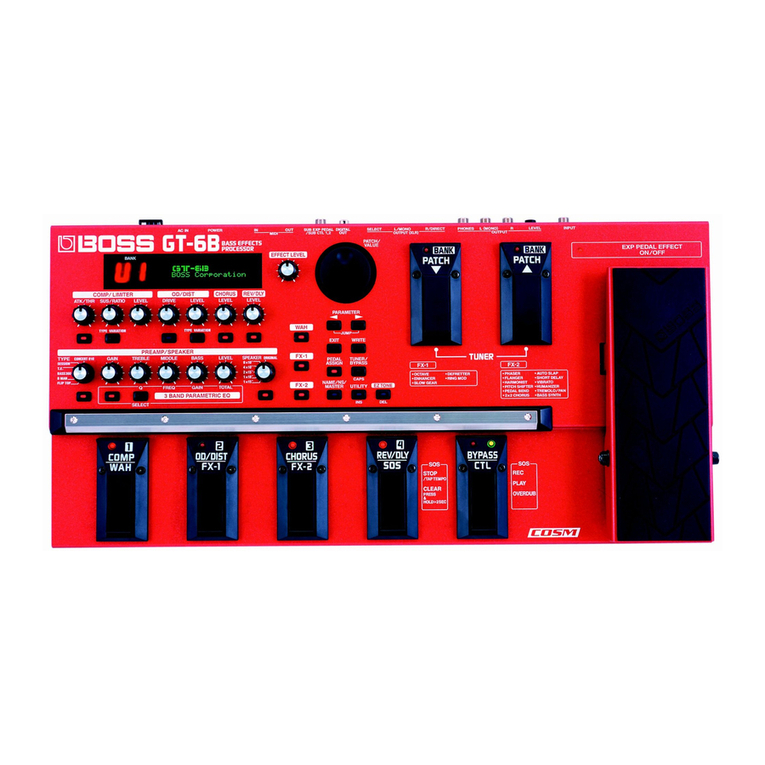
BOSSCO
BOSSCO GT-6B User manual

BOSSCO
BOSSCO ME-50 User manual

BOSSCO
BOSSCO BR-864 User manual
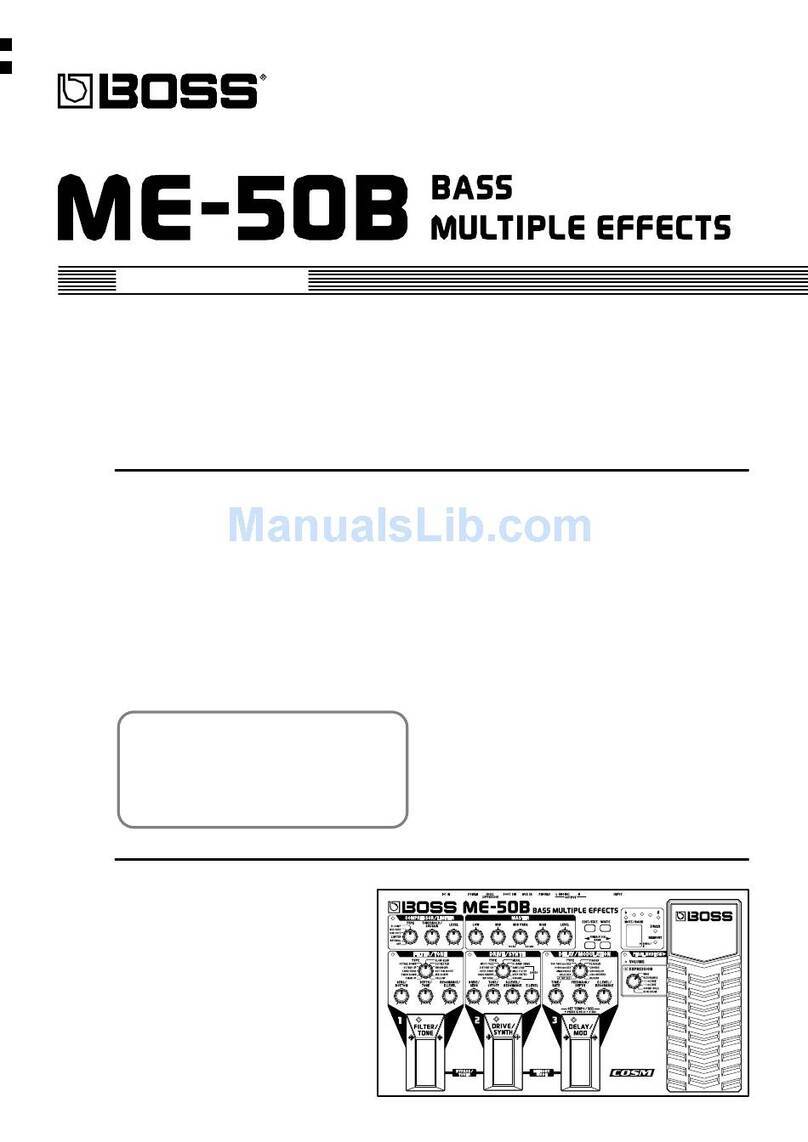
BOSSCO
BOSSCO ME-50B User manual
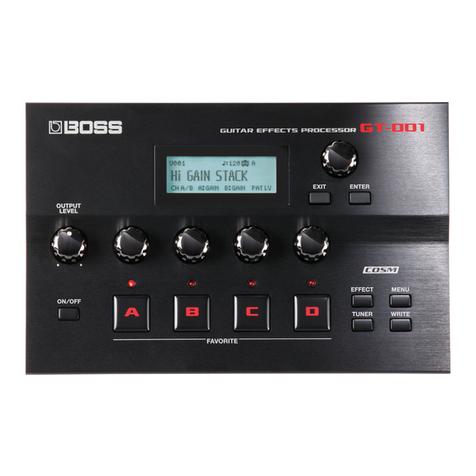
BOSSCO
BOSSCO GT-001 User manual
